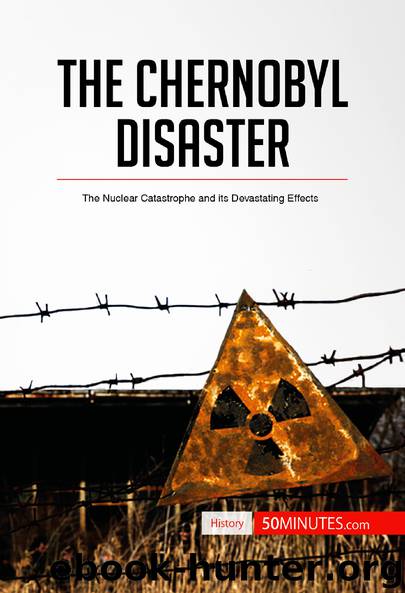The Chernobyl Disaster by 50Minutes.com

Author:50Minutes.com
Language: eng
Format: epub
Publisher: 50Minutes.com
Published: 2017-01-23T00:00:00+00:00
Silence from the authorities
It seems old habits die hard; the local authorities released almost no information whatsoever in the immediate aftermath of the explosion. The accident was only announced two days after the explosion in a brief press release, then an equally brief mention of the incident was made on the evening news. The official statements released in the days which followed maintained a reassuring tone, repeating that the situation was continually improving. Fearing the stir it might cause in the international media, the USSR refused American help on 29 April under the pretence that all problems had been solved. Mayday celebrations took place as normal in Kiev, despite the high levels of radioactivity there at the time. Finally, Gorbachev made a televised announcement on 14 May 1986 in which the accident was officially recognised, though still played-down.
The authorities’ reaction is in part due to their usual tendency to cover up problems and in part due to the difficulty of facing up to such an unexpected disaster. Evacuations began too late and no actions were taken to protect the population from the initial outpouring of radiation, despite the fact that solutions did exist. The team of liquidators also payed the price among this policy of non-recognition; the radiation doses they were received were underplayed and medical directives banning any link between illnesses they developed and their exposure were issued.
Following on from this, the accident was presented in a dramatic light to emphasise Soviet courage. The liquidation process was framed as a war against an invisible enemy; the liquidators were heroes and the authorities in charge of the process were praised for their response. Despite the danger posed by radiation, a Soviet flag was put into reactor no. 4’s chimney at the end of the liquidation effort with a banner attached which read “The Soviet people are stronger than the atom”.
News of the accident goes global
The Swedish were the first to spread word of the catastrophe to the rest of the world. An abnormally high radiation level was detected at the Fosmark nuclear facility during a routine test on the morning of 28 April. It was quickly evacuated in the fear of an undetected leakage. Analysis of wind directions and radioactive particles allowed experts to conclude that this radiation was coming from the Soviet Union. The information was passed on to the European press who diffused the news worldwide.
Download
This site does not store any files on its server. We only index and link to content provided by other sites. Please contact the content providers to delete copyright contents if any and email us, we'll remove relevant links or contents immediately.
The Art of Coaching Workbook by Elena Aguilar(48295)
Trainspotting by Irvine Welsh(20067)
Twilight of the Idols With the Antichrist and Ecce Homo by Friedrich Nietzsche(17709)
Fangirl by Rainbow Rowell(7839)
Periodization Training for Sports by Tudor Bompa(7339)
Change Your Questions, Change Your Life by Marilee Adams(6652)
This Is How You Lose Her by Junot Diaz(5789)
Grit by Angela Duckworth(4742)
Red Sparrow by Jason Matthews(4676)
Asking the Right Questions: A Guide to Critical Thinking by M. Neil Browne & Stuart M. Keeley(4587)
Paper Towns by Green John(4174)
Room 212 by Kate Stewart(4111)
Ken Follett - World without end by Ken Follett(3979)
The Sports Rules Book by Human Kinetics(3593)
Housekeeping by Marilynne Robinson(3406)
The Motorcycle Diaries by Ernesto Che Guevara(3340)
Introduction to Kinesiology by Shirl J. Hoffman(3305)
Exercise Technique Manual for Resistance Training by National Strength & Conditioning Association(3295)
Double Down (Diary of a Wimpy Kid Book 11) by Jeff Kinney(3280)
